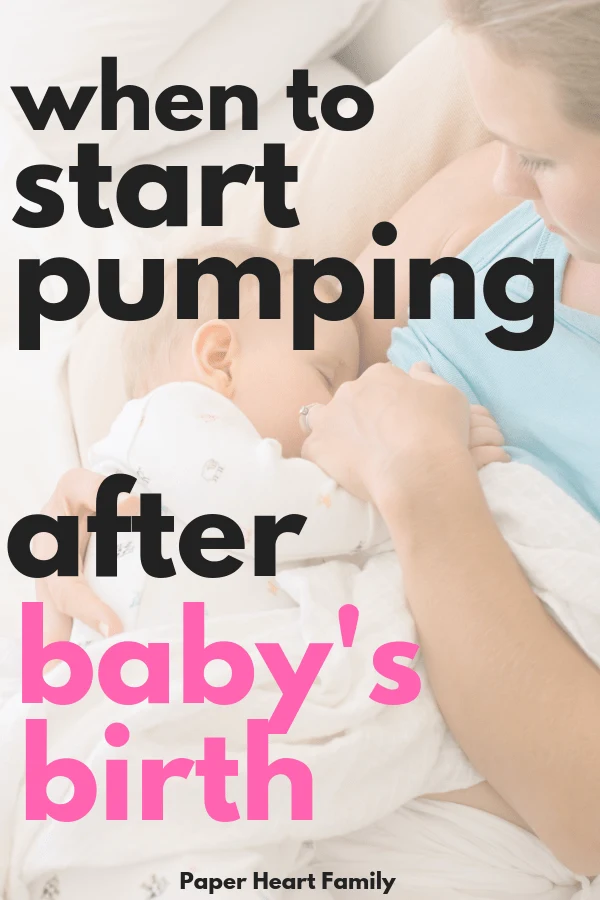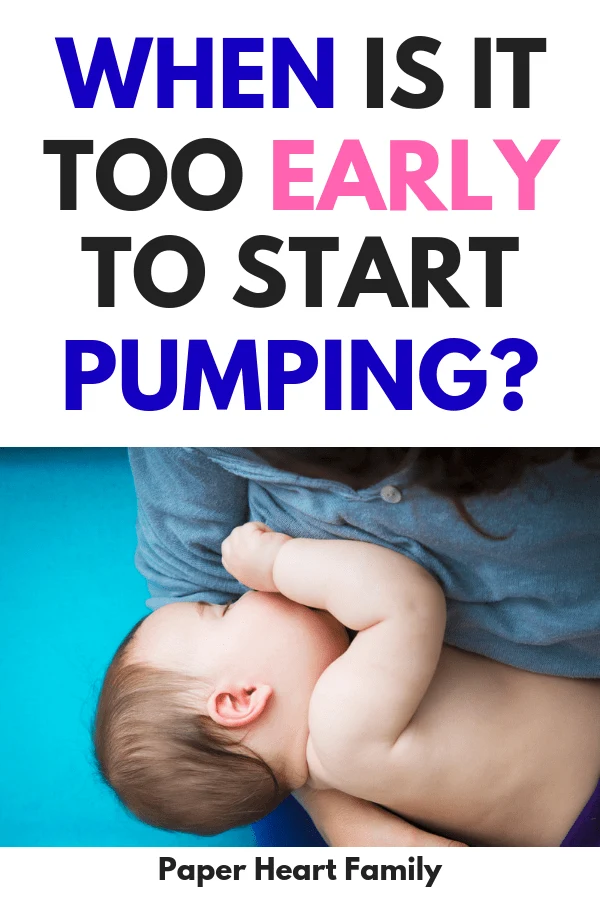After giving birth, you probably have approximately 3,628 questions. If you’re breastfeeding, you might have even more questions. You might be wondering when to start pumping milk after birth.
What I want you to know is that if you just gave birth, RELAX about the pumping (unless absolutely necessary).
I know, I know, you probably think that you have to start a breast milk freezer stash RIGHT NOW. But is pumping after baby is born okay?
Maybe not.
You see, pumping too soon can be a problem (for you AND your baby!).
Related: How To Start Pumping And Bottle Feeding Breast Milk
So let’s start from the beginning.

Should I Start Pumping Before Giving Birth?
Can you start pumping while pregnant? This is an interesting question, and there isn’t a ton of information on the subject.
It appears that some women do pump before the baby is born and do not have any issues. However, breast stimulation can induce labor, and if you are preterm, anything that could potentially induce labor should be strongly avoided.
If you would like to induce labor naturally, simple nipple stimulation (without the use of a breast pump) could help.
If you are hoping to be able to store breast milk before your baby is born in order to build a freezer stash, you will likely be wasting your time. According to Kelly Mom, pumping before birth to increase supply will not increase your milk production. You will also likely not yield much milk at all while pumping before giving birth.
Your milk does not come in until after your baby is born. At first, you will only be producing colostrum.
Because of the risk and little benefit, I suggest that you save the pumping for AFTER you give birth.
Psst. You should also read my amazing tips on breastfeeding for new moms in order to start preparing.
When Is It Too Early To Pump Breast Milk?

There are many reasons why you shouldn’t start pumping very early on. Let’s talk about them.
After giving birth, you’re still recovering and you don’t have the time to pump.
Do you even have time to shower? Probably not.
Pumping is time-consuming, and in the first few weeks, you should be focused solely on you and your baby. You need all of the rest that you can get, and let’s be honest, you’re not getting much rest, and you have very little time for anything else.
Add pumping into the scenario and you’re getting even less.
Pumping too early can also lead to oversupply which is NOT something you want to have to deal with.
When your baby is first born, your body is learning exactly how much milk it should produce for your baby. If you are pumping, your body is going to think it needs to produce too much breast milk.
I had an oversupply without even adding in pumping. If I had been pumping in the first few weeks, I would have been majorly sick. Pumping before your body understands how much milk your baby requires is sending your body the wrong messages.
You’re body will say, oh, let me produce even more! Then you’ve got too much milk, which can cause a whole bunch of problems with breastfeeding such as
- overactive letdown
- engorgement
- very gassy breastfed baby
- fussiness while breastfeeding
- clogged milk ducts
- mastitis
Trust me, you will be fine to wait a little bit longer to pump.
So when is it too early to pump breast milk? Starting to pump at 3 weeks or sooner is probably too early to pump in most cases. At four weeks or later is the best time to start.
However, if your baby was born premature and is having difficulty latching, pumping and bottle feeding might be the way to go. Another possible reason to pump earlier than 4 weeks is if your baby is losing weight. This might mean that you have low milk supply.
How To Collect Milk In The First Four Weeks
If you really want to start saving up some milk in the early days before your baby turns four weeks old, you need the Haakaa.
The Haakaa is a silicone breast pump that you attach to your other breast when your baby is nursing. It is an effective way to collect the milk from your letdowns and even pulls some additional milk from your breast while your baby is eating.
I threw away so many milk soaked nursing pads during my first few weeks of nursing. The Haakaa allows you to catch all the milk that would otherwise be wasted. It can also help you relieve engorgement and manage oversupply in these first few weeks.
The Haakaa makes it possible to start your freezer stash from birth because you’re not actually pumping.
My Favorite Recommended Breast Pumping Products
✔️The Haakaa– This product is GENIUS. It’s a “manual pump” but you don’t have to do any work! Simply suction it to the non-pumping side while your baby is nursing and it will collect milk for you. It’s a great product for when you’re just starting to build a freezer stash.
✔️ A Pump Bag– I adore my Sarah Wells Pump Bag. It’s stylish (doesn’t LOOK like a pump bag!) and it keeps me organized and helps me pump quicker and more efficiently.
✔️ Breast Pump Wipes– Perfect for using at work in-between pumps.
✔️ Storage Bags– for freezing your stash.
✔️ A Double Electric Breast Pump- Read my best breast pump reviews.
When Should I Start Pumping To Build A Stash?
Figuring out how to build a supply of breast milk while breastfeeding and when to start pumping for work is difficult. You probably feel like your baby nurses constantly. Okay, it’s not a feeling, it’s real life. Newborns nurse CONSTANTLY.
But if you know you’re going back to work soon, wondering how to build milk storage while maintaining a breastfeeding routine is a legitimate concern.
As I’ve said before, you really want to be careful about pumping in the first few weeks, as your body could EASILY going into a milk-producing mania and your good milk supply could turn into too much of a good thing.
And while that SOUNDS good, it’s not.
Ideally, when you are trying to create a stockpile of milk, you will wait until about 2-3 weeks before returning to work to start pumping.
Example: If you are going back to work at 6 weeks, don’t start pumping until 4 weeks.
Related: How To Store Milk After Pumping
What if I am going back to work before 6 weeks?
My best advice in this situation is to buy a Haakaa. A Haakaa is an awesome manual pump that allows you to catch milk from one breast while baby nurses from the other (you won’t actually be “pumping”). This way, you aren’t sending the wrong signals to your body, but you’re still able to collect milk.
When Should I Start Pumping For Storage?
A quick search on Pinterest gives me a crazy amount of pins that would make a new mom think that you need to have a freezer stash of hundreds (if not thousands) of ounces. Yikes! That’s intimidating, and you don’t need that stress in your life.
I recommend that you have about 3 days of frozen milk stored. That’s about 50-60 ounces.
Truthfully, the milk that you are going to be giving your milk everyday will likely be the milk that you pumped the previous day. Frozen milk is less nutritional anyway.
I like this article that I read on the subject: Are you a milk hoarder?
She talks about how having a freezer full of milk is an action driven by fear. I have a friend who had hundreds of ounces of frozen breast milk in her freezer. She didn’t return to work, but just had it there in case something happened to her.
I get it. I was like that too. I was fearful of giving my baby formula (even though I know that it wouldn’t have been the end of the world).
How Many Times A Day Should I Pump While Breastfeeding?
How often should you pump? The frequency of times that you pump while still breastfeeding will vary depending upon your situation.
If your baby is between 1-4 weeks old
It is recommended that you do not pump during this time unless necessary due to slow weight gain/low supply. If you do pump during this time, make sure that you have a pumping routine (you are pumping at the same time each day) and that you stick to that schedule.
You are returning to work in 2 weeks
Start pumping once a day so that you can have a supply of approximately 50-60 ounces before returning to work.
Learn about how to develop the perfect pumping and breastfeeding schedule for work.
You are experiencing low milk supply
In this case, you should pump as much as you want and follow my tips on increasing milk supply. It might be a good idea to pump immediately after each feeding or about 30 minutes after each feeding.
You are experiencing engorgement
If you are engorged, pump only when it is necessary (if you are in extreme pain, for example). Pump ONLY until you get some relief (a couple minutes at most). The best way in this case however, is hand expression. Again, you do not want your body to produce even more milk, therefore becoming more engorged.
You have returned to work
If you are pumping because you have returned to work, you should try to pump as often as your baby would nurse during that time (every three hours). This will likely equate to pumping 3 times throughout your workday (for a typical 8 hour day). Make sure that you follow a pumping schedule that is the same each day while at work.
How Much Milk Should I Be Pumping?
If you take nothing else that I have said to heart, please pay close attention to this pumping tip. If you are pumping before baby is 4 weeks old, expect to pump very little. Your baby is still consuming very little milk at this time.
After the 4 week mark, you still need to realize that your body will take some time to increase the amount of milk that it produces and to get used to the pump. A baby’s latch and the suction from a breast pump are VERY different. One is natural. One is not. It’s normal for your body to take some time to respond to the pump.
The amount that you are able to pump will also depend on other factors such as:
✔️Your baby’s age
✔️The time of baby’s last nursing session- if you are pumping right after nursing, you’ll likely get much less
✔️The time of day (first thing in the morning is typically the best)
✔️The type of pump you are using (a hospital-grade pump is always the best)
With all of that said, average ounces per pumping session are typically between .5-2 ounces per breast.
Does the idea of returning to work and managing to pump enough milk for your baby worry you?
Dumb question, right?
The Ultimate Back To Work Pumping Class will absolutely ease your mind (and teach you everything you need to know to successfully pump at work for as long as you’d like!)
The creator of this unique online and on-demand video class is a real-life mom and certified lactation consultant. She teaches everything pumping from start to finish, including choosing a pump, talking with your employer about pumping, how to store and care for your milk, how to introduce a bottle, maintain your supply, and more! Check out everything that the class includes here.
Frequently Asked Questions
Can pumping mess up breastfeeding?
Yes, if done incorrectly. Pumping too often can cause an oversupply, which can lead to overactive letdown (this can cause discomfort, gassiness and green, frothy stools for your baby). Also, pumping immediately before breastfeeding can mean that there might not be enough breast milk left for your baby.
Is it easier to pump or breastfeed?
Breastfeeding is much, much simpler. Pumping includes washing pump parts, being tied down to your pump and being on a strict pumping schedule. Breastfeeding on demand can be done anywhere. The only thing needed is you and your baby. A baby nursing is also much more efficient than a pump.
How often do you pump after birth?
Pumping after birth is not necessary, and could interfere with precious skin-to-skin bonding time with your baby. Also, your baby is going to be much more efficient at stimulating your milk to come in. Save the pumping for after your breastfeeding relationship is established.

How To Start Pumping And Bottle Feeding Breast Milk
Tuesday 18th of April 2023
[…] Don’t start pumping too soon! It could cause some major problems. Find out the best time to start pumping breast milk. […]
Breastfeeding And Pumping Schedule- When Should You Pump?
Tuesday 18th of April 2023
[…] Read more about the best time to start pumping. […]
Timeline of a Breastfed Baby- What To Expect From Birth To Weaning
Sunday 9th of April 2023
[…] difficulties exist like latching problems, blocked ducts, figuring out when to start pumping and mastitis, you are also dealing with normal, sometimes frustrating nursing […]
Breast Milk Pumping Tips For Beginners From An Exclusive Pumper – Paper Heart Family
Monday 28th of November 2022
[…] There are a few different scenarios to address in order to provide you with the best advice on when to start your breast milk pumping regimen. […]
Best Breast Pump Reviews Of 2022- Find The Best Breast Pump For YOU
Friday 24th of June 2022
[…] If you start pumping to early, you could be confusing your body into producing more milk than necessary, which can QUICKLY result in a problematic oversupply. The ideal time to start pumping is around 4 weeks, however there are other factors that could influence the time in which you start to pump. Read more to figure out when to start pumping. […]